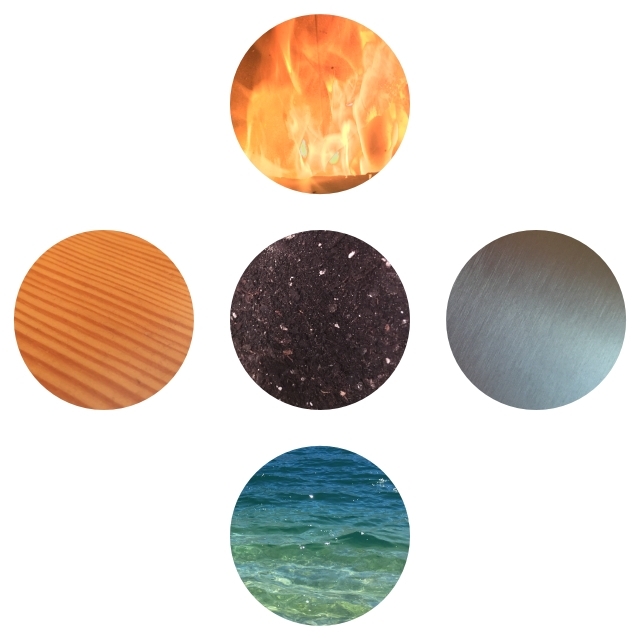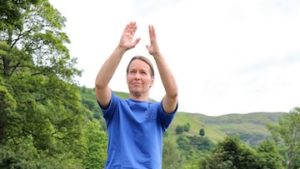The five elements Qigong exercises are also known as “Qigong of the 5 Phases” or “5 Elements Harmony”. In this article, Franziska Rüscher, Qigong teacher from Austria, explains the philosophical background of the Qigong set and the five individual exercises step-by-step.
Tip: After reading this article about the theory see also our article 5 Elements Qigong with instruction and videos!

The 5 elements (or 5 changes) are rooted in Daoist philosophy and aim to explain natural developments in the nature surrounding us as well as in human life itself. This old Chinese thought system puts the earth in the middle and refers the remaining 4 elements onto two rectangular axes:

Vertical:
Water at the bottom (big Yin)
Fire at the top (big Yang)
Horizontal:
Wood left (small Yang)
Metal right (small Yin)
In the cycle of seasons, a phase of 73 days is attributed to each outer element: WOOD – FIRE – METAL – WATER
After each of these 4 phases, there are 18 days of earth time, which correspond to the periods before the spring and autumnal equinoxes and the summer and winter solstices. The earth – as planet that we live on – thus provides the link between the elements.
Using the five elements as a reference, almost every phenomenon can be understood in a new way as an expression of the five elements: the phases of life, the compass directions, the different types of food, the parts of the human body, emotions, colours, forms, therapies etc. This provides a link of the 5 element theory to Traditional Chinese Medicine and Qigong practice.
Some examples:
WOOD (small Yang)

is associated with birth and growth, new beginning, the morning, the spring and the East.
In the human body, the wooden element is connected to liver and gall bladder, eyes, muscles, sinews and finger nails.
Patience, tolerance, flexibility and creativity are signs of a positive energy flow, whereas rage, anger, jealousy and frustration point towards a blockade of the energy flow.
The movement of wood is upward.
FIRE (big Yang)

is associated with formation and development, midday, summer and the South.
In the human body, the heart, the perikardium, the small intestine, the triple warmer, the blood vessels and the tongue are attributed to the fire element.
Mental clarity, a peace-loving temper, curiosity and enthusiasm are the positive characteristics of fire, whereas desire, confusion, excessive excitement and hysterical behaviour rate among its negative characteristics.
The movement of fire is directed outwards.
EARTH (Middle)

is associated with maturity, adulthood, afternoon and late summer.
In the human body, the element is connected to the spleen, the pancreas, the stomach, the connective tissue, the flesh and the mouth.
Rationality, Caring, readiness to help and concentration indicate a harmonic energy flow, whereas fanaticism, doubt and brooding are symptoms of a disharmonic energy flow.
Being centred is attributed to the element earth.
METAL (small Yin)

is associated with post-ripening, harvest, evening, autumn and the West.
In the human body, metal is connected to the lungs, the large intestine, the skin, the body hair and the nose.
Selfless and just actions as well as generosity are the positive, grief, hopelessness, dependency and egoism are the negative properties of metal.
The movement of metal is directed inwards.
WATER (big Yin)

is linked to the enjoyment of the harvest, old age, night, winter and the North.
In the human body, the element is associated with the kidney and the bladder, the bones, the hair and the ears.
Fearlessness, strength of will and wisdom show the harmonic energy flow, whereas fear and obsession with power hint at energy blockades.
The movement of water is directed downwards.
Video 5 Elements Qigong, easy beginner version
See also our article 5 Elements Qigong with instructions for training at home.
Recommended reading on 5 Elements Qigong Theory
Author: Franziska Rüscher, translation from the German article by Taiji-Forum
Images: Eagle Verlag (Franz Mittermair) and Taiji-Forum
